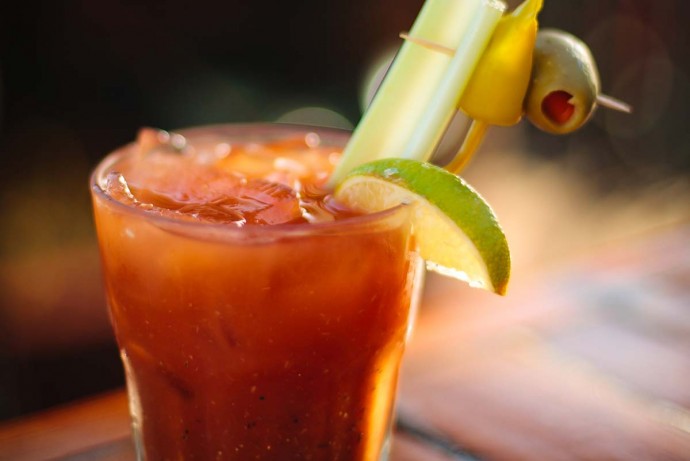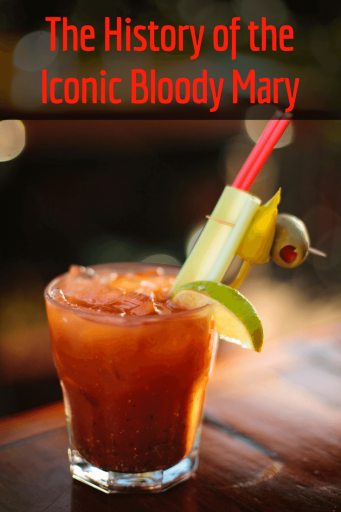Ernest Hemingway stumbles into his favorite bar in Paris, wracked with a powerful headache from the previous night’s debauchery. He mutters something incoherent to the bartender, who knows the man well enough to understand he’s looking for a little hair of the dog. He decides to experiment this morning, combining vodka, tomato juice, and a smattering of sauces and spices in his shaker. Voila! Brunch in a glass. Papa Doble sucks the whole thing down in one gulp and declares it the greatest drink ever invented—a superlative he’s thrown around a number of times, but the barman knows he means it in the moment.
It’s a fun and oft-repeated story, but it’s almost certainly bullshit. While we wouldn’t necessarily call the history of the Bloody Mary nuanced, it’s definitely shrouded in a good deal of folklore and grandstanding nonsense. The proposed dates of its invention range from the 1920s to the 1940s, with Paris, New York, and Palm Beach jockeying for position as its birthplace, but beyond hometown pride there’s little reason to believe one story over another.
In our research, we’ve narrowed the Bloody Mary’s origins down to two likely stories: that of the famed Harry’s New York Bar in Paris, and that of George Jessel, whose tale includes both Florida and New York. There are dozens of other, more tenuous claims, but to explore those in detail would probably require a book deal.
The History of the Bloody Mary
The first, and probably most famous claim is the one dramatized in our introduction, which was put forth by Fernand Petiot a few times over the course of his life (though, as far as we can tell, the Hemingway connection seems to have been tacked on by others). Petiot was a bartender at the New York Bar in the early 1920s—before it was Harry’s—and declared in a 1964 interview with The New Yorker that he had come up with the Bloody Mary recipe while working there:
“‘I initiated the Bloody Mary of today,’ he told us. ‘Jessel said he created it, but it was really nothing but vodka and tomato juice when I took it over. I cover the bottom of the shaker with four large dashes of salt, two dashes of black pepper, two dashes of cayenne pepper, and a layer of Worcestershire sauce; I then add a dash of lemon juice and some cracked ice, put in two ounces of vodka and two ounces of thick tomato juice, shake, strain, and pour…'”
Petiot’s quotation, of course, invites an obvious question: who was George Jessel? In short, he was a beloved, hard-drinking comedian and actor whose career spanned half a century and everything from Vaudeville to silent films and television. His claim to the drink comes from his autobiography, in which he recounts a particularly hungover (or, likely, still intoxicated) morning in Palm Beach in 1927.
He and his companions had apparently tried everything to kill their headaches, and thanks to an imminent business meeting they were getting desperate. Their bartender, amused, dug around under the bar and produced a bottle of vodka—a relatively unknown commodity in the US at the time—and said it was the last thing he could offer them that might do the trick. Jessel thought it smelled like “rotten potatoes,” so he asked for some tomato juice to mellow it out, and thus his version of the Bloody Mary was born.
Who Invented the Bloody Mary?
So, who gets the credit? Thanks to their connection to Hemingway, Fitzgerald, Stein, and all the other great American expats of the Lost Generation, Petiot and Harry’s New York Bar are the usual winners, at least in the court of public opinion. But as far as we can tell, the answer lies in Petiot’s words themselves: “…it was really nothing but vodka and tomato juice when I took it over.”
The phrasing would seem to imply that, while he didn’t think the drink was worthy of the name Bloody Mary, Petiot agreed that Jessel was responsible for first mixing—or at least popularizing—a cocktail comprised of vodka and tomato juice. It’s not much to go on, so we can’t say for sure if that was the case, and neither Petiot nor Jessel are still around to interview for more details. But it’s the best we’ve got.
From Palm Beach, and all the numerous bars and cocktail parties Jessel frequented as the “Toastmaster General of the United States,” it’s likely that the Bloody Mary made its way to Petiot’s new stateside bar at the St. Regis Hotel in New York City. He adjusted (and, as most would agree, drastically improved) the recipe, making it the drink it is today. From there, it spread throughout the country and across the Atlantic to Paris, where it would eventually be made at Harry’s.
Clearly, some wires have gotten crossed over the decades, with personal pride and a few too many drunken nights clouding up some significant parts of the story. But perhaps that’s part of the allure of the Bloody Mary, that its origins will always be a mystery—at the very least, they’ll always make for good conversation as you recover over brunch.
Photo: Aurimas via Flickr




